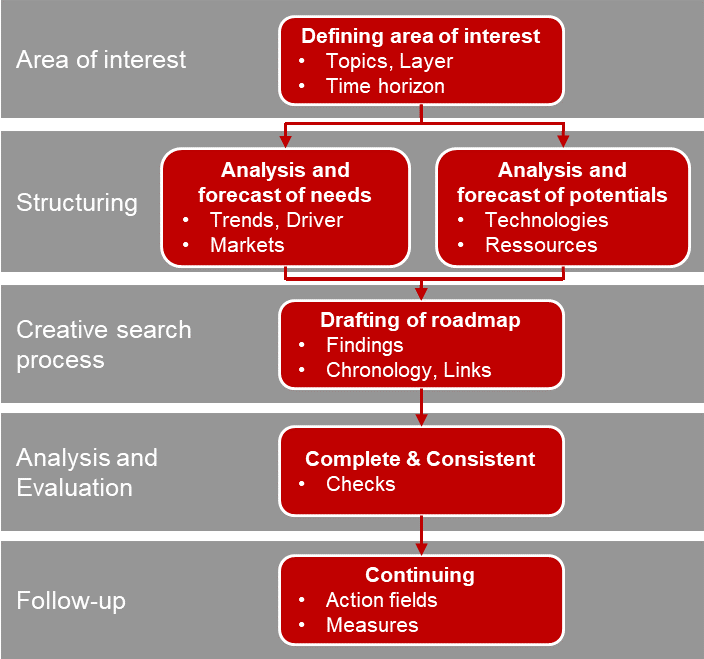6) H&C transition strategy
Step six is about agreeing on a strategy with milestones comparable to a roadmap and supporting the development of spatial planning policies to help implement the roadmap, for example through facilitating private development and investment. The scenarios from step five form the basis of this step and will typically involve workshop discussions with stakeholders. The outcome of step six is a strategy in the form of a roadmap with strategic goals (e.g. increase the renovation rate by X% by 2030) set within the framework of the scenarios considered most promising by as many stakeholders as possible.
To develop the transition strategy, roadmapping is a suitable solution. Roadmaps provide decision-makers in business and politics with an overview of the interrelationships, conditions and opportunities of a change process over time. Through an intensive examination of future opportunities and risks, the actors in politics and business can specify upcoming development steps and responsibilities. Thus, the roadmap process not only serves to identify and structure strategies but also to communicate development goals and their framework conditions.
Roadmapping: Illustrating a complex transition over time
There are different definitions of a roadmap. A roadmap is a graphical representation of change processes over time. What they have in common is (i) a reference to the future (but not a prediction), (ii) a chronological linking of the aspects depicted and (iii) working towards a vision or goal.
Roadmaps usually have several layers. In political-strategic roadmaps, these layers often map the drivers and barriers to the desired transition, as well as measures to steer change towards the goal. A simple exemplary layer design is given in the following figure.
Exemplary roadmapping layers to develop an H&C transition strateGY

Roadmapping: Questions and steps
Roadmapping can be done in five steps. First, the area of interest is defined by determining which topics and time horizons are considered. This is followed by structuring. Here, needs and potential analyis as well as forecasts help. Based on this, the roadmap is drafted in the third step by organising the findings chronologically and linking them to each other. This is followed by an analysis of completeness and consistency. In the last step, concrete fields of action and measures are derived from the roadmap.
Roadmapping steps
Tools / Literature on Scenarios
- Rob Phaal: AN INTRODUCTORY GUIDE TO STRATEGIC AND TECHNOLOGY ROADMAPS. Centre for Technology Management, Institute for Manufacturing, University of Cambridge. Internet: https://1mof951r5i942b5d2k1qlf8j-wpengine.netdna-ssl.com/wp-content/uploads/IfM_Roadmapping_V8.pdf
- Roadmapping templates and resources. Internet: https://engage.ifm.eng.cam.ac.uk/roadmapping-templates/
- Case Studies. Internet: https://engage.ifm.eng.cam.ac.uk/roadmapping-case-studies/
Subscribe to our Newsletter

This project has received funding from the European Union’s Horizon 2020 research and innovation program under grant agreement No 101033706. The sole responsibility for the content of this website lies with the Act!onHeat project and does not necessarily reflect the opinion of the European Union.





